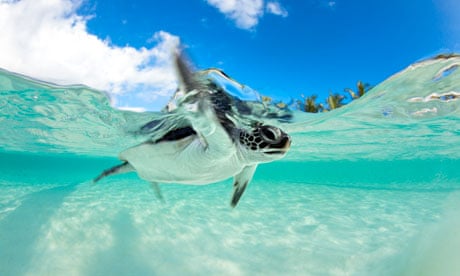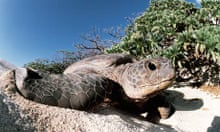It's another perfect day on Watamu beach in Kenya, as tourists sip lunchtime cocktails beside the pool and contemplate an afternoon of water sports. Down the road that runs behind the growing line of beach resorts, tourists watch two turtles that are flipping forlornly around shaded ponds in a rehabilitation centre.
Hetty Meggy, the project manager of Local Ocean Trust's Watamu Turtle Watch (WTW), is telling them about Shela, a green turtle hit by a tourist boat who now struggles with her buoyancy, and Chokoraa, a hawksbill whose intestines were "literally made of plastic" when he was rescued.
Of the turtles admitted to the centre, 62% are there because of human-related causes – many associated with tourism. While people come to Kenya hoping to see turtles, increasing tourist numbers are putting pressure on the population. And fewer turtles will in turn mean Kenya's tourism industry will suffer.
Tourism has boomed along Kenya's 500km coastline in the past 30 years, as increasing numbers of European and American tourists have been attracted by the clear turquoise waters, white sandy beaches and abundant wildlife.
Much of the Kenyan coast has been developed, with beaches around Mombasa among the most heavily built-up coastal areas north of South Africa. Lamu, Watamu and Malindi are also established holiday destinations, while emerging areas include the Arabuko-Sokoke and Kaya coastal forests and the Tana delta.
Given that every eight tourists are estimated to create one job, this is good news for the local economy. But it's not such a welcome trend for sea turtles, who are seeing their nesting sites reduced by erosion, and who are killed by pollution and poaching.
Five of the world's seven species of turtle are found in Kenya – green, hawksbill and olive ridleys nest along the coast, and the loggerheads and leatherbacks migrate through the waters. All five species of marine turtles found in African waters are listed by the IUCN as endangered or critically endangered. The world population is estimated to have declined by 80% over the past 50 years, and the WWF says trends indicate that in the next 50 years marine turtles may vanish from eastern Africa.
"Turtles are an indicative species. When you have turtles in the sea then it means the seas are healthy," says Douglas Maina, assistant project coordinator at Kenya Sea Turtle Conservation and Management Trust (Kescom), an umbrella organisation bringing together community-based turtle conservation groups. "Without them, the whole ecosystem can break down."
For millennia, turtles have come ashore between one and 10 times a year to lay their eggs on pristine, deserted beaches. But this ancient ritual is under enormous threat because the nesting and foraging sites where the turtles lay their eggs have become prime beachfront real estate.
"Coastal developments are one of the top five threats to sea turtles. Because of the loss of land, turtles may waste their eggs in the sea or lay them in an inappropriate location, reducing their chance of survival. The greatest problem is when an entire beach is affected by coastal developments," says Meggy.

Along many parts of the coast, souvenirs are hawked from semi-permanent illegal beachfront "banda" huts, which along with beach furniture and sand castles are hazardous to turtles. On some beaches, vehicle traffic compacting the sand has made it impossible for female turtles to dig nests. Boats motor in and off the shore, and music and lights blare from beachfront discos. Females turtles will not lay eggs if they are disturbed by bright lights, loud noises or people on the beach.
Hatchlings locate the water's edge by heading for the horizon, but house and street lights can make them crawl away from the sea. The odds for hatchlings are already slim – only one in 1,000 make it to adulthood. "And humans are working against that every day," says Meggy.
Suitable nesting sites are being reduced by erosion from the construction of ports, jetties, marinas and hotels. Attempts to control the shoreline by building sea walls, dredging and sand-filling are destroying important feeding grounds, altering nesting beaches and causing loss of large volumes of sand.
Turtles are also being killed by water pollution, choking or starving after swallowing plastic debris. Heavy metals and tar balls from oil spills have been found in their systems. Rubbish on beaches can prevent hatchlings from reaching the ocean, and leaves them exposed to predators.
The potentially fatal disease fibropapillomatosis, which causes tumour-like growths on soft tissue, is also afflicting increasing numbers of turtles. The growths often cover the eyes of the turtles, causing blindness, which can lead to slow starvation because the turtles cannot see to find food. Though not yet scientifically proven, the disease has been linked to water pollution because many of the affected turtles were found near areas of heavy human use and terrestrial run-off.
"When I came here 10 years ago there was only one boat in the harbour. Now there are boats everywhere and the water is full of diesel – you can taste it," said one tourist visiting Watamu.
And turtles are still being extensively exploited for their meat, oil and shells – despite national and international laws.
All of these problems are compounded by the lack of comprehensive data on population size, nesting and foraging sites, migration and mortality. In the future, turtles will face emerging threats due to climate change.

At national level, turtles and their habitats are protected by four national parks and five reserves that come under the mandate of the Kenya Wildlife Service (KWS) and the Fisheries Department. In the parks, there is complete protection of natural resources, and the only activities allowed are tourism and research. Some human activities are allowed in the reserves.
At present, the law does not protect turtle and nesting and foraging sites outside protected areas, and this is where development is taking place.
Nesting sites are being spoiled by illegal development that is too close to the high water mark. "There are dollar signs in people's eyes when they think of tourists," says Meggy.
Conservationists say the development must be controlled. "There is a paradox – we are trying to encourage tourism yet we must conserve the beaches. We have to advocate development that does not impact negatively on the marine environment," Maina says.
Experts say highly valued beachfront land is more likely to be owned by Kenya's political elite who have entered into partnership with foreign investors, than local people who have an interest in protecting the environment.
"Land issues along the Kenya coast land have been historically very tense, with deep-seated issues with absentee land ownership," says Fred Nelson of Maliasili Initiatives, who wrote a 2007 paper on coastal tourism trends in east Africa.
Turtle conservation and management is increasingly shifting to local communities, with the support of groups like Kescom. It supports 19 initiatives along the coast that carry out habitat restoration, beach clean-ups, collecting data, nest monitoring and education and awareness programmes.
WTW is a Kescom project, and Meggy says that because of its work, Watamu main beach has become one of Kenya's few safe havens for nesting turtles.
"Community-based conservation is a huge and important dynamic trend. It's early days, but it looks like Kenya is becoming a leader within east Africa for developing the legal framework for the community to take charge and manage its ecosystems," said Nelson.
"With any conservation challenge, the community has got to be involved in making and enforcing the rules and regulation. If it's all top-down it's not going to work. The government is not going to have the capacity or the will to police marine areas."

Responsible operators in the tourism industry are raising awareness of the plight of turtles among hotel, staff and beach operators. Damian Davies, general manager of Turtle Bay Beach Club in Watamu, which supports WTW with a monthly donation, said: "We are only too aware of the potential negative impacts of the rapidly developing tourist market and associated coastal development on the turtle populations in Watamu. We work to preserve the delicate ecosystem that is our beach, and we are always looking for new ways to further mitigate the impact of the development in the area."
The club's responsible beach management programme includes a ban on bright, seaward-facing lights, running beach clean-up programmes, plastics recycling projects and promoting good marine practice.
Tourists can also play their part after the holiday is over. "Tourists need to put pressure on the Kenyan government to enforce marine protection legislation. The marine parks and wildlife are not equally protected. People's main focus in east Africa is protecting elephants and cheetahs, but we must encourage the protection of all endangered African wildlife," Meggy says. "We must ensure that people do not destroy what they came to enjoy."



Comments (…)
Sign in or create your Guardian account to join the discussion